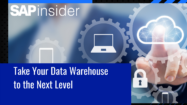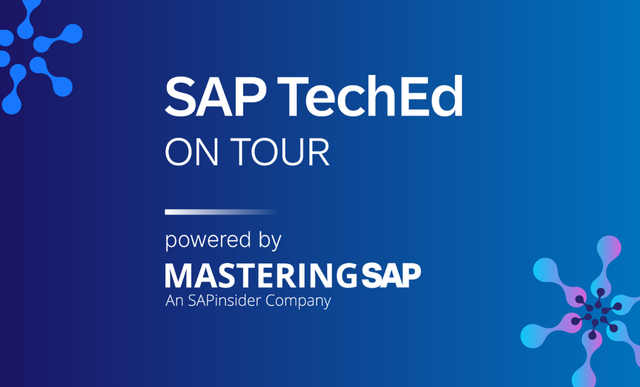SAP S/4HANA
Filter By
Browse By
- SAP Analytics and AI
- SAP Application Development and Integration
- All SAP Application Development and Integration
- SAP ABAP
- SAP ABAP Development Tools
- SAP ABAP Test Cockpit
- SAP API Management
- SAP BAPI
- SAP Basis
- SAP BRF
- SAP Business Application Studio
- SAP CMS
- SAP Design Studio
- SAP Development Tools
- SAP DevOps
- SAP EAI
- SAP EDI
- SAP Extension Suite
- SAP Fiori
- SAP Fiori Elements
- SAP Integration Suite
- SAP Low Code Application Development
- SAP Low Code Automation
- SAP Netweaver
- SAP Release Management
- SAP UI5
- SAP Web Application Server
- SAP Web IDE
- SAP Business Process Management
- SAP Center of Excellence
- SAP CIO
- SAP Customer Experience
- SAP Data and Data Management
- All SAP Data and Data Management
- SAP BW
- SAP BW/4HANA
- SAP Crystal Reporting
- SAP Data Archiving
- SAP Data Center
- SAP Data Governance
- SAP Data Integration
- SAP Data Migration
- SAP Data Quality
- SAP Data Services
- SAP Data Strategy
- SAP Data Visualization
- SAP Data Warehouse Cloud
- SAP DMS
- SAP Document Control
- SAP EIM
- SAP ETL
- SAP ETL Tools
- SAP HANA
- SAP HANA Administration
- SAP HANA Deployment Infrastructure
- SAP HANA Studio
- SAP Master Data
- SAP Master Data Governance
- SAP MDM
- SAP Enterprise Architect
- SAP Enterprise Asset Management
- SAP ERP
- SAP Finance
- All SAP Finance
- SAP Accounting
- SAP AR AP
- SAP Asset Accounting
- SAP Billing Systems
- SAP BPC
- SAP BRIM
- SAP Cash Management
- SAP Central Finance
- SAP Controlling
- SAP COPA
- SAP Cost Center Accounting
- SAP e-invoicing
- SAP FICO
- SAP Finance Automation
- SAP Financial Closing Cockpit
- SAP Financial Consolidation
- SAP Financial Planning
- SAP FX Risk
- SAP General Ledger
- SAP Global Tax Management
- SAP Hyperion
- SAP Order to Cash
- SAP Payment Processing
- SAP Profitability Analysis
- SAP Rebate Management
- SAP S/4HANA Finance
- SAP Universal Journal
- SAP Governance Risk and Compliance
- SAP Human Capital Management
- SAP Intelligent Technologies
- SAP Platform and Technology
- All SAP Platform and Technology
- SAP Business Technology Platform
- SAP Cloud Connector
- SAP Cloud Integration Platform
- SAP Cloud Migration
- SAP Cloud Platform
- SAP Cloud Providers
- SAP Cloud Strategy
- SAP Container Platform
- SAP Digital Asset Management
- SAP Digital Integration Hub
- SAP Digital Signature
- SAP HANA Enterprise Cloud
- SAP HEC
- SAP Hyperscalers
- SAP Infrastructure
- SAP Messaging
- SAP Smart Forms
- SAP Quality and Testing
- SAP Security
- SAP Spend Management
- SAP Supply Chain Management
- All SAP Supply Chain Management
- SAP APO
- SAP Asset Management
- SAP Business Network
- SAP Digital Manufacturing Cloud
- SAP Digital Twin
- SAP EWM
- SAP IBP
- SAP Inventory Management
- SAP Label Printing
- SAP Logistics
- SAP Manufacturing
- SAP Manufacturing Automation
- SAP MES
- SAP MII
- SAP MM
- SAP MRO
- SAP MRP
- SAP Order Management
- SAP Plant Maintenance
- SAP PLM
- SAP Production Planning
- SAP S&OP
- SAP SD
- SAP SPM
- SAP Supply Chain Planning
- SAP Track and Trace
- SAP Transportation Management
- SAP System Administration
SAP S/4HANA: An Overview and Key Considerations
What Is SAP S/4HANA?
Enterprise Resource Planning (ERP) has been the cornerstone of SAP solutions since the company was founded in 1972. SAP’s first packaged mainframe software application, SAP R/2, was released in 1979, and was followed by SAP R/3, SAP ERP Central Component (ECC) 5.0, and SAP ECC 6.0. SAP’s current flagship enterprise ERP solution, SAP S/4HANA, was released in 2015, and was a significant shift for the organization as it ran exclusively on the SAP HANA database.
Modules included in an SAP S/4HANA system include: Asset Management, Finance, Human Resources, Manufacturing, R&D/Engineering, Sales, Service, Sourcing and Procurement, and Supply Chain. Each of these modules consist of multiple applications that offer specific features and functionality, as well as industry-specific and enhanced line-of-business functions.
SAP S/4HANA: An Overview and Key Considerations
What Is SAP S/4HANA?
Enterprise Resource Planning (ERP) has been the cornerstone of SAP solutions since the company was founded in 1972. SAP’s first packaged mainframe software application, SAP R/2, was released in 1979, and was followed by SAP R/3, SAP ERP Central Component (ECC) 5.0, and SAP ECC 6.0. SAP’s current flagship enterprise ERP solution, SAP S/4HANA, was released in 2015, and was a significant shift for the organization as it ran exclusively on the SAP HANA database.
Modules included in an SAP S/4HANA system include: Asset Management, Finance, Human Resources, Manufacturing, R&D/Engineering, Sales, Service, Sourcing and Procurement, and Supply Chain. Each of these modules consist of multiple applications that offer specific features and functionality, as well as industry-specific and enhanced line-of-business functions.
Key Considerations for SAPinsiders
- SAP S/4HANA is the solution that SAP wants enterprise ERP customers to be running, but it is about more than simply adopting technology. According to Tom Janoshalmi, the former Global Head of SAP Digital Core Move, organizations need to look at their move to SAP S/4HANA to being about a connected story not just a technology upgrade. While SAPinsider research has shown that many organizations look at SAP S/4HANA largely because of the upcoming end of maintenance for core SAP ERP releases, more see a move to SAP S/4HANA as the opportunity to re-engineer and update processes and configurations. Janoshalmi agrees. He wants organizations to focus on the value they can derive from SAP S/4HANA and what they can achieve moving forward. You can hear more about why the move to SAP S/4HANA is important by reading SAPinsider’s interview with Janoshalmi.
- SAP S/4HANA is the core around which organizations can build their transformed landscape. When Eczacıbaşı Building Products needed to update their existing systems and processes, they looked at SAP S/4HANA as the central part of their update. The overall process involved a complete evaluation of all their current processes and implementing technologies that would increase agility while boosting customer brand experience. SAP S/4HANA was used to connect all the different parts of the business in that process. This article covers more about the Eczacıbaşı project, as does this event session where they discuss their results.
- SAP continues to enhance SAP S/4HANA by including it in RISE with SAP. RISE with SAP is not a new product, but an offering that includes assets that help organizations achieve transformation. The central part of this is SAP S/4HANA Cloud, the software-as-a-service version of SAP’s flagship ERP solution. Damien Johnson from SAP explains in this session what RISE with SAP is, and how it impacts organizations’ existing SAP S/4HANA projects.
952 results
-

Optimize Your Supply Chain with SAP Solutions
Published: 01/October/2017
Reading time: 9 mins
Panelists: Martin Rowan and David Carroll Date: Wednesday, October 4 Are you leveraging all the capabilities in your existing SAP systems to optimize your supply chain? Whether you are trying to minimize inventory levels, improve service performance, reduce stock-outs, or all the above, there is likely functionality you are not using. Plus, you likely need to prepare…
-

- SAP ERP
 Premium
Premium
Customers Call for Cloud and On-Premise Equality
Published: 04/August/2023
Reading time: 6 mins
During SAP’s 2023 Q2 earnings call, SAP’s CEO Christian Klein made several statements about how innovations in generative AI and sustainability to be exclusively available in the cloud. Klein also indicated that these new offerings would only be available to RISE with SAP and GROW with SAP customers. While no specific information was provided in…
-

SAP Shops S/4HANA Public Cloud to Retail for Supply Chain Fix
Published: 10/January/2025
Reading time: 3 mins
SAP has launched the SAP S/4HANA Cloud Public Edition tailored specifically for retailers, featuring enhanced supply chain capabilities aimed at optimising inventory management, improving operational efficiency, and facilitating omnichannel operations.
-
-

SAP Brings AI to Everything, Everywhere at Sapphire
Published: 21/May/2025
Reading time: 3 mins
The Day 1 keynote of Sapphire highlighted SAP’s focus on AI integration within its Business Suite and partnerships aimed at simplifying migrations to cloud solutions.
-

Choosing Your Path to SAP S/4HANA: Greenfield, Selective Transition, or Brownfield?
Published: 01/October/2024
Reading time: 1 min
The infographic presents three distinct approaches to transitioning to SAP S/4HANA: Greenfield, Selective Transition, and Brownfield. Each method offers unique advantages and challenges based on organisational needs, such as cost, system customisation, and business disruption. The Greenfield approach provides a fresh start with SAP best practices, while the Selective Transition allows phased data and process…
-

Take Your Data Warehouse to the Next Level
Published: 05/November/2020
Reading time: 6 mins
To make good use of all the data streaming in from internal and external sources, companies must be able to organize and store that data in a way that enables optimal analysis, so that they can make the right business decisions. This is where data warehouses come in, which serve as a central repository of…
-

Take Control of Mergers and Acquisitions
Published: 27/January/2017
Reading time: 8 mins
As businesses pursue growth in the digital age, there has been an uptick in the rate of mergers and acquisitions (M&As). While M&As help organizations expand their capabilities and extend new offerings to their customers, they also bring unique challenges — organizations must work hard to integrate IT systems and obtain a single source of…
-
-

Break Free from On-Premise Complexity
Published: 21/April/2017
Reading time: 6 mins
Increasing demand from customers for innovation and convenience has played a major role in moving businesses toward cloud technology, as the cloud allows organizations to be more agile and responsive to customer needs. Recognizing this trend — and the needs of its customers — SAP released SAP S/4HANA Cloud, an end-to-end ERP system purpose-built for…
-

Bridging the Data-Driven to Insights-Driven Gap with SAP BW/4HANA
Published: 25/April/2018
Reading time: 6 mins
Discover how SAP BW/4HANA integrated with SAP Analytics can help your organization distill data into actionable insights that can spur the growth of your business. Learn about three challenges related to data and analytics and how SAP BW/4HANA enables your business to take three strategic steps toward evolving into an insights-driven organization.
-

Leverage Bank Account Management for Payment Signatories based Payment Approvals
Published: 18/March/2021
Reading time: 12 mins
In today’s global and dynamic business environment, treasury departments are faced with the daunting task of managing and controlling large sets of bank accounts across diverse geographies. Some of the challenges include maintaining optimum bank structure, managing large portfolios of bank accounts and signatories, and maintaining relationships with banks. Applying the right degree of automation…
Featured Experts
-

-

-

Varun Bhatt
Partner - SAP Rise
Become a Member
Unlimited access to thousands of resources for SAP-specific expertise that can only be found here.
Upcoming Events
-

SAP TechEd on Tour, powered by Mastering SAP
November 12 - 14, 2025
Sydney, New South Wales
Australia
View Event
Related Vendors
Your request has been successfully sent

